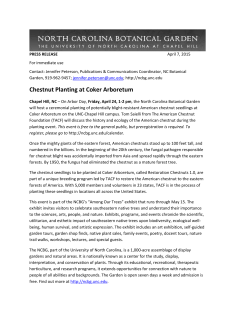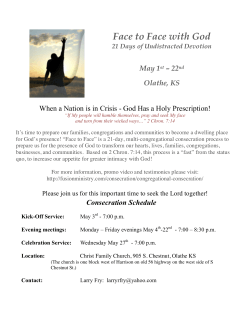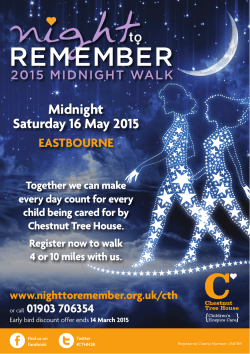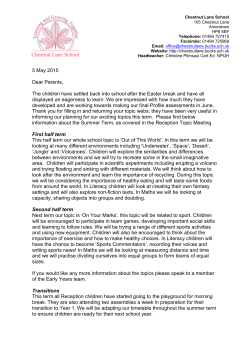
Chinq 23-1 spring 2015 - Southern Appalachian Botanical Society
CHINQUAPIN The Newsletter of the Southern appalachian Botanical Society Volume 23 (1) Winter 2015 Boykin’s Lobelia – and a Plea for Rare Species Research By Linda Chafin, State Botanical Garden of Georgia, University of Georgia, Athens After a two-year break, the rare plant column is back. Thanks to the Southern Appalachian Botanical Society for the kind welcome back to the pages of Chinquapin! As a botanist who studies and writes about rare plants, I am frequently reminded how little scientists know about the biology of most rare species, and how even what we think we know sometimes turns out to be wrong. My conservation horticulturist colleagues here at the State Botanical Garden of Georgia often start from scratch as they develop propagation and re-introduction protocols for the rare species they raise for restoration projects–basic knowledge such as type of seed dormancy and soil nutrient requirements is often lacking. Occasionally, even the most basic natural history fact – is a species annual or perennial? – is in dispute. There is little funding out there for conducting life history studies of rare plants, and Natural Heritage programs, a vital source of information on rare species for the last four decades, are experiencing dire funding cuts and loss of mission throughout the country. When a species does receive detailed and long-term study, the findings are often eye-opening–and of great value to conservationists and land managers. Among the best studied rare plant species in our area is Boykin’s Lobelia, Lobelia boykinii. Historically known from the Gulf and Atlantic Coastal Plains of eight states (MS, AL, FL, GA, SC, NC, DE, NJ), Boykin’s Lobelia is considered by NatureServe to be critically imperiled in five states, and imperiled or vulnerable in three. It is currently under consideration by the U.S. Fish and Wildlife Service for listing as Threatened or Endangered. Boykin’s Lobelia is a rhizomatous perennial distinguished by its spongy-thickened stem base, filiform leaves, and flowers 10 - 13 mm long (a bit less than ½ inch). It is an obligate wetland inhabitant of Carolina Bays, limesink ponds, cypress-gum ponds, and depressions in flatwoods and savannas. Studies conducted throughout the 1990s by Elizabeth Lacey and her students Ramona Bates, Alejandro Royo, and Rachel Moreno, at UNC-Greensboro illuminated details of the species’ genetic variation, reproductive biology, interactions with other species, and habitat requirements that bear on the rarity, management, and long-term prospects of Lobelia boykinii. They determined that Lobelia boykinii is an obligate outcrosser whose reproduction is therefore limited by the small population sizes throughout most of its range. These researchers also found that reproduction was affected by low numbers of pollinating insects – perhaps attributable to widespread insecticide spraying in nearby agricultural fields. They also determined that hydrology and fire frequency play critical roles in the survival of the species, results with immediate implications for site management. Lacey and her group also suggested that sophisticated mathematical techniques, such as population dynamic studies, be used to predict population and species survival in Lobelia boykinii and other rare plant species. Field surveys also continue to reveal new information about Boykin’s Lobelia – ask Bill McAvoy, botanist with Delaware’s Species Conservation and Research Program (formerly the Natural Heritage program). In 2013, McAvoy and his colleague, Ronald Wilson, were surveying Delaware’s Coastal Plain ponds for Dichanthelium hirstii, another globally rare species and Federal candidate. Imagine their surprise when they ran across 14 stems (3 in flower) of Boykin’s Lobelia, not seen in Delaware in 100 years! And this in a site that had been repeatedly surveyed for rare species over the past 29 years. McAvoy and Wilson speculate that Hurricane Sandy, which flooded the site in late October 2012, created conditions that promoted bolting and flowering in Lobelia plants that had long persisted as rhizomes and sterile rosettes. But in their article they also note: “Conversely, a population of L. boykinii in New Jersey produced over 200 flowering plants on a ‘dry pond bottom’... Only long-term population monitoring throughout the range of the species can reveal even some of [Lobelia boykinii’s] secrets.” If even the well-studied Boykin’s Lobelia can continue to surLobelia continued on Page 2 2 Chinquapin 23 (1) SABS Officers and Executive Council For full addresses, see http://sabs.appstate.edu/about/officers Kathy Gould Mathews President (2014-2016) Western Carolina University (828) 227-3659 kmathews@email.wcu.edu Wendy Zomlefer Past President (2014-2015) University of Georgia (706) 583-0389 wendyz@plantbio.uga.edu Charles N. Horn Treasurer (2014-2018) Newberry College (803) 321-5257, fax (803) 321-5636 charles.horn@newberry.edu Michael E. Held Membership Secretary (2012-2015) Saint Peter’s University (201) 761-6432 mheld@saintpeters.edu Susan Farmer Recording Secretary (2013-2016) Abraham Baldwin Agricultural College (229) 391-5126 sfarmer@abac.edu Brian Keener Member at Large (2013-2015) University of West Alabama (205) 652-3796 bkeener@uwa.edu Lisa Kelly Member at Large (2014-2016) University of North Carolina at Pembroke (910) 325-1470 lisa.kelly@uncp.edu Jay Bolin Member at Large (2014-2016) Catawba College (704) 637-4450 jfbolin@catawba.edu Christopher P. Randle Editor-in-Chief of Castanea (2014-2017) Sam Houston State University (936) 294-1401 cpr003@shsu.edu Joe Pollard Chinquapin Editor (2012-2015) Department of Biology Furman University 3300 Poinsett Highway Greenville, SC 29613 (864) 294-3244 joe.pollard@furman.edu The Newsletter of the Southern Appalachian Botanical Society From The Editor’s Desk: Joe Pollard, Newsletter Editor We have a very full issue this time, so I’ll keep my remarks brief. I’m especially happy to welcome Linda Chafin back to the pages of Chinquapin. Linda’s regular column on rare plants went on hiatus a couple of years ago as she prepared a book on the wildflowers of Georgia for UGA Press. I look forward to seeing the finished product, and in the meantime it’s good to have Linda’s insights back in Chinquapin. For a new twist in this issue, George Ellison gives us a “Botanical Excursion” in the form of a poem. Alan Weakley and Lytton Musselman continue their series. And we welcome a new author, Martin Cipollini of Berry College, with a timely update on American Chestnut. Enjoy! Lobelia continued from Page 1 prise, what might we learn from studying more obscure rare taxa such as those in Eriocaulon, or Rhynchospora, or Dichanthelium? This article is a plea to all concerned about the loss of biodiversity in this country: Support basic botanical research in our universities, botanical gardens, and state natural resource agencies. Fund herbaria and their staff as they build and protect priceless collections. Resurrect the Natural Heritage programs in those states where they’ve lost funding and vision. We have so much to lose otherwise and a world of biodiversity to gain. And, as we research, study, and protect our natural heritage, we humans stand to gain, as Aldo Leopold wrote: “…a sense of kinship with fellow-creatures, a wish to live and let live, a sense of wonder over the magnitude and duration of the biotic enterprise.” Bates, R. 1996. The reproductive biology of Lobelia boykinii. M.S. Thesis, University of North Carolina at Greensboro. Lacey, E. P., A. A. Royo, R. Bates, and D. Herr. 2001. The role of population dynamic models in biogeographic studies: An illustration from a study of Lobelia boykinii, a rare species endemic to the Carolina Bays. Castanea 66: 115-125 Leopold, A. 1953. A Sand County Almanac and Sketches Here and There. Oxford University Press, New York. McAvoy, W.A. and R.M. Wilson. 2014. Rediscovery of Lobelia boykinii (Campanulaceae) in Delaware. Phytoneuron 2014-23:1–4. Moreno, R. 2003. Genetic variation in three populations of a rare plant Lobelia boykinii: A microsatellite analysis. M.S. Thesis. University of North Carolina at Greensboro. NatureServe. 2015. NatureServe Explorer: An online encyclopedia of life. NatureServe, Arlington, Virginia. http://explorer.natureserve.org/. Royo, A.A., R. Bates, and E.P. Lacey. 2008. Demographic constraints in three populations of Lobelia boykinii: a rare wetland endemic. Journal of Torrey Botanical Society 135(2):189-199. Royo, A. 1998. Demographic modeling of Lobelia boykinii, a rare species endemic to the Carolina Bays. M.S. Thesis, University of North Carolina at Greensboro. Bereavements We are saddened to report that two influential southeastern botanists passed away recently. Dr. John E. Fairey, III died on February 1, 2015, at the age of 74. Dr. Fairey received his Ph.D. from the University of West Virginia, and taught biology and botany at Clemson University for over 30 years. He served the Southern Appalachian Botanical Society as Vice-President in 1981-82 and President in 1982-83. Dr. Wade T. Batson, Jr. died on February 14, 2015, at the age of 102. Dr. Batson received his Ph.D. from Duke University, and was a faculty member at the University of South Carolina for 30 years. He received many awards during his distinguished career, including being honored on his 100th birthday by a resolution passed in the South Carolina General Assembly. Full obituaries and tributes for these two outstanding individuals are in preparation for publication in Castanea. On the web at sabs.appstate.edu Chinquapin 23 (1) 3 Taxonomic Advisory! The Tangled Taxonomy of Southeastern United States Vines (part 2) By Alan S. Weakley, Director, University of North Carolina Herbarium (NCU, North Carolina Botanical Garden, University of North Carolina at Chapel Hill) Here twisting across the pages is the tantalizingly promised part two of the tangled taxonomy of our lissome lianas. As always, I provide here only a brief summary of reasons for the changes, and the reader who wants to understand and independently evaluate the details is encouraged to seek out the more technical publications cited. Some of the changes discussed below remain unsettled and may change further (or back). Muscadinia rotundifolia (Michaux) Small var. rotundifolia, Common Muscadine, Scuppernong (VITACEAE) Synonymy: = Muscadinia rotundifolia var. rotundifolia – Weakley et al. 2011; = Vitis rotundifolia Michaux – some previous eastern North American references; = Vitis rotundifolia Michaux var. rotundifolia – some previous eastern North American sources; = M. rotundifolia (Michaux) Small – Small (1933) Muscadinia rotundifolia (Michaux) Small var. munsoniana Weakley & Gandhi, Munson Grape, Bullace Grape, Munson’s Muscadine (VITACEAE) Synonymy: = Muscadinia rotundifolia var. munsoniana – Weakley et al. (2011); = Muscadinia munsoniana (J.H. Simpson ex Planchon) Small – Small (1933); = Vitis rotundifolia Michaux var. munsoniana (J.H. Simpson ex Munson) M.O. Moore – most previous eastern North American references; = V. munsoniana J.H. Simpson ex Munson Muscadinia rotundifolia (Michaux) Small var. pygmaea (MacFarlin ex D.B. Ward) Weakley & Gandhi, Pygmy Munson Grape, Scrub Grape (VITACEAE) Synonymy: = Muscadinia rotundifolia var. pygmaea – Weakley et al. (2011); = Vitis rotundifolia var. pygmaea MacFarlin ex D.B. Ward – Ward (2006) An archetypal Southeastern United States plant (even mentioned in the second stanza of the Official State Toast of North Carolina: “Here’s to the land of the cotton bloom white, Where the scuppernong perfumes the breeze at night, Where the soft southern moss and jessamine mate, ‘Neath the murmuring pines of the Old North State!), the muscadines or scuppernongs have been taxonomically controversial and variably treated for a century, and it seems likely that they may continue to be controversial. The first issue is generic – are they to be treated as a distinctive subgenus of Vitis, or as their own genus? Most recent systematic studies using molecular techniques show that the muscadines and the “true grapes” are sister to one another and separate clades, matching the long assumed relationship based on morphological and other similarities and differences. In a case such as this one, where each group is monophyletic and the two groups are most closely related to one another, the taxonomist or floristician can emphasize similarity by treating them as two subgenera in a genus, or alternatively can emphasize difference by treating them as two genera. Vitaceae expert Jun Wen (of the Smithsonian Institution) prefers the subgeneric treatment, but I am accepting them as two genera, based on the genetic distance between Muscadinia and Vitis s.s., the different chromosome numbers (40 in Muscadinia, 38 in Vitis s.s.), the frequent past and current recognition of Muscadinia, the substantial morphological distinctiveness of genera in the Vitaceae, and the rampant interbreedability of the species in Vitis s.s. and the inability to cross Muscadinia with Vitis s.s. (Ren et al. 2011; Péros et al 2011; Tröndle et al. 2010; Rossetto et al. 2002; Soejima & Wen 2006; Weakley et al. 2011). The second controversy regards the number of taxa in Muscadinia, and their appropriate ranks. In the southeastern United States, 1-3 taxa have been recognized, variously at specific and varietal rank in different combinations; an additional species, Muscadinia popenoei (J.L. Fennell) Weakley & Gandhi, is restricted to southern Mexico and northern Central America. The “rotundifolia” entity is widespread in the southeastern United States. The “munsoniana” entity is more restricted, occurring widely in Florida, north to southern Georgia and southern Alabama, and disjunct in the Bahamas; it has been variously regarded as merely an intergrading form, a variety, or a full species. The “pygmaea” entity has generally been ignored until promoted by Dan Ward in the past decade, when he elevated it from a form to a variety; it is a narrow endemic in scrub in the Florida peninsula. The treatment shown above, recognizing three varieties under Muscadinia rotundifolia seems a conservative and prudent approach until additional clarity is achieved. Guilandina bonduc Linnaeus, Gray Nicker (FABACEAE) Synonymy: = Guilandina bonduc – Small (1933); Caesalpinia bonduc (Linnaeus) Rozburgh – most previous eastern North American references Guilandina has been resplit from Caesalpinia by Lewis et al. (2005), corroborated by molecular systematic studies by Gagnon et al. (2013). As shown by the authority of the epithet and the synonymy above, such a judgment is nothing new, having been applied by Linnaeus and J.K. Small. Guilandina ends up as a small genus of about seven species, pantropical in distribution, and famous for its viciously armed and strikingly rampant growth, well-known for its gray beans (used as toys, game pieces, marbles, and medicine) and its abundant retrorse prickles, earning it an alternate common name of “Holdback”. Thyrsanthella difformis (Walter) Pichon, Climbing Dogbane (APOCYNACEAE) Synonymy: = Thyrsanthella difformis – Livshultz et al. (2007), Wunderlin & Hansen (2011); = Trachelospermum difforme (Walter) A. Gray – most previous eastern North American references This species has been traditionally treated as the only North American taxon of Trachelospermum, an otherwise se. Asian genus of about 15-20 species. Such a treatment is untenable, however, as morphological and molecular evidence clearly show that our native taxon is only distantly related to Asian Trachelospermum (Livshultz et al. 2007). Our species is a monotypic species of eastern North America. Taxonomic Advisory continued on Page 4 4 Chinquapin 23 (1) The Newsletter of the Southern Appalachian Botanical Society Botanical Excursions Rhododendron Tunnels By George Ellison Where ancient animal trails and footpaths threaded their way through rhododendron thickets or heath balds called laurel hells the branching overarching limbs formed dimly-lit tunnels at either end of which (depending on whether you’re coming or going) there’s the proverbial light you say you’ve been looking for. The corridor narrows your space to the here and now . . . debris crackles softly under your feet . . . overhead waxy leaves float motionless in the bluish-green almost subterranean air … you reach out and touch the reddish-brown bark with your fingertips. As you pass out of the shade into the sunlight you pause while your eyes slowly readjust and a bird sings from somewhere in the dense tangle: three down-slurred notes followed by a musical cascade that fades into the imperfect silence. Without looking back you move on … but the image of the calm open-ended passage resurfaces in your mind’s eye wherever you might be when the unseen bird sings: Sweer Sweer Sweer che-di-wit che-de-wit ... swee yuu . .. and you descend all over again (just like Alice down the rabbit hole) below the surface of everydayness into that quiet realm of watchful intentness. Artwork by Elizabeth Ellison. George and Elizabeth Ellison are based in Bryson City, NC. www.georgeellison.com ; www.elizabethellisonwatercolors.com Taxonomic Advisory continued from Page 3 Cynanchum laeve (Michaux) Persoon, Sandvine, Honeyvine, Bluevine (APOCYNACEAE) Synonymy: = Cynanchum laeve – some previous eastern North American sources; = Ampelamus albidus (Nuttall) Britton – some previous eastern North American sources; = Gonolobus laevis Michaux – Small (1933); = Ampelamus laevis (Michaux) Krings – Krings (2001), Wunderlin & Hansen (2011) Orthosia scoparia (Nuttall) Liede & Meve, Leafless Swallow-wort (APOCYNACEAE) Synonymy: = Orthosia scoparia – Liede-Schumann & Meve (2008); = Cynanchum scoparium Nuttall – most previous eastern North American sources; = Amphistelma scoparia (Nuttall) Small – Small (1933) Seutera angustifolia (Persoon) Fishbein & W.D. Stevens, Swallow-wort (APOCYNACEAE) Synonymy: = Seutera angustifolia – Fishbein & Stevens (2005); = Cynanchum angustifolium Persoon – some previous eastern North American sources; = Cynanchum palustre (Pursh) Heller – Radford, Ahles, & Bell (1968); = Lyonia palustris (Pursh) Small – Small (1933); = Funastrum angustifolium (Persoon) Liede & Meve – Liede & Meve (2003) These have been considered in Cynanchum or variously in other genera, complicated by both taxonomic and merely nomenclatural issues. The above is a plausible and provisional account of the appropriate treatment of these cynanchoids, based on recent research with the goal of recognizing meaningful and monophyletic genera: Liede (1997a, 1997b), Liede & Meve (1997, 2003), Krings (2001), Liede & Täuber (2002), Fishbein & Stevens (2005), Liede-Schumann & Meve (2008), Liede-Schumann et al. (2014). It remains plausible, though, that Cynanchum laeve should and will be recognized as Ampelamus laevis (separating it from the largely Old World Cynanchum), and that Seutera angustifolia will be included in Funastrum as Funastrum angustifolium. Isotrema macrophyllum (Lamarck) C.F. Reed, Pipevine, Dutchman’s-pipe (ARISTOLOCHIACEAE) Synonymy: = Isotrema macrophyllum – Weakley, Ludwig, & Townsend (2013); = Aristolochia macrophylla Lamarck – most previous eastern North American sources; = Aristolochia durior Hill – some previous eastern North American sources Isotrema tomentosum (Sims) H. Huber, Woolly Dutchman’s-pipe, Pipevine (ARISTOLOCHIACEAE) Synonymy: = Aristolochia tomentosa Sims – nearly all previous eastern North American sources Based on work by Ohi-Toma et al. (2006), our eastern North American Aristolochia species are not actually closely related to Aristlolochia, unless that genus is circumscribed in such a broad manner as to include a large and heterogenous diversity of plants. Ohi-Toma (2006) places our woody vining “Aristolochia” in the genus Isotrema, and in a separate subtribe in Aristolochiaceae from Aristolochia s.s. References for Alan Weakley’s article are posted online at http:// sabs.appstate.edu/chinquapin-issues. On the web at sabs.appstate.edu Chinquapin 23 (1) 5 Chaffseed, Schwalbea americana By Lytton John Musselman, Old Dominion University, Norfolk, VA The father of American botany, Asa Gray, described the namesake of Schwalbea, C. G. Schwalbe, as “an obscure Dutch botanist”. Turns out the eponymous genus is also obscure. Chaffseed is one of the rarest root parasites in the Eastern United States. Suppression of fires in much of its range, along with habitat destruction in the longleaf pine savanna system, resulted in a demise of chaffseed. Because of this, it is a federally listed endangered species. The largest extant populations have regular fire such as the frequently burned habitats at Fort Bragg in North Carolina, the Jones Ecological Research Center in southern Georgia, and several longleaf communities maintained for quail hunting also in Georgia. Chaffseed is restricted to the Coastal Plain from east Texas to Long Island, New York though it is extirpated in much of its historical range like Virginia where the last specimens were collected about seventy-five years ago. Two species of Schwalbea have been described—S. americana and S. australis. Like the botanist the genus commemorates, differences between the two species are obscure, based on pubescence and leaf size. I agree with most recent authors who recognize only one species, S. americana. A perennial, apparently short-lived, this parasite--like other hemi-parasites in the Orobanchaceae-- belies its duplicitous existence with green, somewhat fleshy leaves. It grows to a height of about two feet. Unlike other hemi-parasites in this family, leaves are alternate (Fig.1). Chaffseed, so named because of the small, elongate flesh-colored seeds, differs from relatives like Agalinis, Aureolaria and Seymeria having large trumpet-shaped or disc-shaped corollas. Rather, the corollas of chaffseed are two-lipped and tubular, resembling its cousins Pedicularis, Castilleja, and Melampyrum. The color of the corolla is a tawny-mauve (I am looking for descriptors; in any event an unusual floral color). Bees are reportedly the pollinating agents though I have not seen this. Studying parasitism, I Figure 1. Habit of chaffseed showing the alternate, hairy found chaffleaves. seed most frequently parasitizing inkberry (Ilex glabra), a common component of longleaf pine communities. So host distribution does not explain its rarity. In pot studies, I was able to document Figure 2. Chaffseed flowers, Socastee Savanna (now deparasitism stroyed), Horry County, South Carolina. on a wide range of hardwoods and conifers. Pot studies are not dependable predictors of host selection in nature, however. Like all parasitic plants, the haustorium, formed by the roots of Schwalbea, is the conduit for transfer of materials between host and parasite. Seeds are easy to germinate but little is known of seed behavior under natural conditions. The role of fire may be to clear vegetation and litter for germination. Like virtually all of the herbaceous hemi-parasites, chaffseed requires full sun to power transpirational pull on its host. This is not a spectacular plant. But with its alternate leaves, peculiar haustoria, and unusual flower color, it is distinctive. And a large population of Schwalbea is an indicator of fire conditions favorable Figure 3. Cross section of a chaffseed haustorium (upper to savanna half ) on a root of inkberry (lower half ). The vascular plants. continuity is obvious in this image with strands of xylem extending between host and parasite (middle center). 6 Chinquapin 23 (1) The Newsletter of the Southern Appalachian Botanical Society Botanical Brainteasers By Joe Pollard and Janie Marlow The plants depicted in the winter Brainteasers [Chinquapin 22(4)] were (1) Cichorium intybus, (2) Cicuta maculata, (3) Claytonia virginica, (4) Apios americana and (5) Helianthus tuberosus. This time around the puzzle wasn’t based on the names or classifications of the plants, but on their uses by humans. Four out of the five are known for edible tubers or other starchy structures. But don’t try that with #2, commonly known as Water Hemlock! It has tubers but they’re deadly poisonous, so it is – seriously – the odd one out. Only five readers responded on this one, but three out of the five, Sam Pratt, Donna Ford-Werntz, and Jean Everett, got it exactly right. Sam answered first, so we declare him the winner of this puzzle. To calculate a winner for the year, we assigned points based on accurately identifying the plants, figuring out the puzzle (or at least guessing what we intended), and submitting the answers quickly. Of course, those who played every time had a big advantage over occasional participants, but every player is appreciated! So … (drum-roll) … the winner of the 2014 Botanical Brainteaser competition is Jean Everett, a self-described “flat-lander” from the College of Charleston. Congratulations Jean! We’ll be sending you a copy of Woody Plants of Kentucky and Tennessee, by Ronald Jones and Eugene Wofford. And now we start a new series. Identify the plants, and explain why one of the five doesn’t belong in the group and is the odd one out. The prize this year will be a copy of Linda Chafin’s new book on the Wildflowers of Georgia, which is currently in press and should be just hitting the market about a year from now. Color photos are online at http:// sabs.appstate.edu/chinquapin-issues. Please address all correspondence regarding Botanical Brainteasers to joe_pollard@att.net. (That’s an underscore character between first and last names.) If you prefer, send snail-mail to Joe Pollard, Biology Department, Furman University, 3300 Poinsett Highway, Greenville, SC 29613. Images are ©JK Marlow. No. 3 No. 1 No. 4 No. 2 No. 5 On the web at sabs.appstate.edu Chinquapin 23 (1) 7 Breeding for Disease Resistance in American Chestnut in the Southern U.S.: The Role of State Chapters of The American Chestnut Foundation By Martin L. Cipollini, Berry College, Mount Berry, GA and Tom Saielli, The American Chestnut Foundation, Asheville, NC Most botanists are well aware of the demise of the American chestnut (Castanea dentata [Marsh.] Borkh.) due to fungal blight (Cryphonectria parasitica [Murrill] Barr) (TACF 2015a). On the other hand, some may be unaware of the progress being made toward the return of disease-resistant trees to our forests and of some of the key challenges to restoration that go beyond blight itself. American chestnuts once covered more than 200 million acres, ranging from Maine to Florida and were particularly abundant along the spine of the Appalachians. It has been estimated that four billion chestnut trees, perhaps as much as 25% of all hardwoods in some locations, once grew within this range (TACF 2015b). Range maps for the south suggest that American chestnut was at least an occasional constituent of Coastal Plain forests and occurred in both Piedmont and Ridge and Valley provinces. Its ecological characteristics made it an integral foundation species of many forests. Late blooming (usually mid-June), and thereby avoiding spring frosts, the tree tends to produce a consistent annual seed crop. The combination of abundance and predictability suggest that American chestnut was an incredibly important food resource for wildlife. Furthermore, rural communities depended upon its reliable nut harvest as a cash crop and to feed livestock, and relied heavily on the tree for the timber and tannin industries. In the south, a first wave of devastation came in the mid-1800s with black ink disease (Phytophthora cinnamomi Rands), likely responsible for its loss from most Coastal Plain and many Piedmont sites (Rhoades et al. 2003). The more widespread and infamous decline came when fungal blight spread from the north in the early-1900s. By the 1950s, the tree was eliminated as a functional component of most forests, existing only as occasional stump sprouts that tend to die before reaching maturity. Local economies built around the tree crashed. In 1983, The American Chestnut Foundation (TACF) initiated a breeding program focused on breeding blight-resistance from Chinese chestnut (C. mollissima Blume) into American chestnut, while recovering the American chestnut phenotype through progressive generations of backcrossing (Hebard 2014). This method involves hybridizing Chinese chestnut with American chestnut through controlled pollinations, and then successively backcrossing blight-resistant progeny with American chestnut to produce blight-resistant trees that contain approximately 94% American chestnut germplasm (TACF 2015a). The first generation of potentially blight-resistant American chestnut has been named “Restoration Chestnut 1.0” and began to be released for field tests in 2005. These trees are now in a phase of rigorous long-term field trials in both forest and orchard settings, including progeny test plantings in a number of southern sites. TACF’s long-term goal is to restore a sexually-reproducing population of American chestnut throughout its native range, thus restoring the species’ ability to evolve on its own (Hebard 2014). To accomplish this, American chestnut genetics needs to be captured from throughout its range. Most early breeding work focused on trees from certain locations (e.g., VA, PA, and CT) and focused exclusively on blight resistance. This is where state chapters of TACF come into play. Starting in the early 1990s, 15 state chapters of TACF have been established, including chapters in AL, GA, KY, NC/SC, and TN in the southern region. A principle goal of state chapters is to incorporate regional American chestnut genetics into TACF’s breeding program, thus conserving genetic diversity and facilitating the production of regional lines for restoration. Secondly, state chapters focus on opportunities and problems unique to their region. For example, on the opportunity side, southern chapters have engaged in programs to test American chestnuts and hybrids for use in strip-mine reclamation projects. On the challenge side, southern chapters have focused time and energy on breeding for Phytophthora resistance and on developing tactics to deal with other regional problems, such as the Asian Ambrosia Beetles that are common pests in southern orchards. Southern chapters presently have just about 1200 members for an area that covers about 100,000 square miles. There are currently 74 backcross orchards, two seed orchards, four Phytophthora resistance screening programs and three Phytophthora resistance breeding orchards, 13 progeny test orchards, six special research plantings, several Germplasm Conservation Orchards (GCOs), and hundreds of ceremonial and demo plantings. Southern chapters are collaborating on a “Southern Heritage Tree” breeding program designed to produce lines of trees adapted to southern habitats using new sources of disease resistance. Some members have also been engaged in parallel work on chestnut genetics, genetic engineering, and cloning (via somatic embryogenesis) of disease resistant trees. The on-going classical breeding program will be necessary to incorporate genetic diversity into lines used for restoration even if transgenic trees obtain federal approval and public acceptance. Much of the work that has been done by state chapters has been done via “citizen science” projects that depend heavily on private individuals and partner organizations helping to educate the public, monitor trees, collect data, and breed and grow trees on behalf of TACF. State chapters are comprised almost exclusively of volunteers, save for a few paid interns. We encourage readers of Chinquapin to join a state chapter and to volunteer their services (by joining TACF at http://www.acf.org/ one automatically becomes a member of a state chapter). Despite the expanse of challenges still facing the success of this program, expertise in plant ecology, breeding, genetics, ecophysiology, phytopathology, silviculture, etc. is at a premium in most state chapters (with total membership hovering around 200 per state). Please see this article partly as an appeal to those with technical expertise to join our program as it makes its transition from breeding phase to the restoration phase. American Chestnut continued on Page 8 Charles N. Horn, PhD, Treasurer Southern Appalachian Botanical Society Newberry College 2100 College Street Newberry, SC 29108 PRSTD. STD. U.S. POSTAGE PAID ASHEVILLE, NC PERMIT 575 Return Service Requested American Chestnut continued from Page 7 This is an exciting time in TACF’s progress toward re-establishing American chestnut to our native forests, and professional botanists, volunteers, contributors, and all members from the southern states have a tremendous role to play. Martin L. Cipollini is Dana Professor of Biology at Berry College, Mount Berry, GA, and can be contacted at mcipollini@ berry.edu. Tom Saielli is the Southern Regional Science Coordinator of the The American Chestnut Foundation in Asheville, NC, and may be contacted at tom@acf.org References: Chestnut blight-inoculation crew at the Berry College backcross orchard in May 2013, a project conducted in collaboration with the Georgia Chapter of the American Chestnut Foundation. Selected trees from this orchard will be among the first blight-resistant progeny of American chestnuts from the state of Georgia. From left to right: Martin L. Cipollini (Berry College), Lynne Womack (Georgia Forestry Commission), Tom Saielli (The American Chestnut Foundation), and Sam Watkins, Theron Kantelis, and Erin Coughlin (Berry College). 8 Chinquapin 23 (1) Hebard, F. 2014. Overview of the TACF Breeding Program. NE1333 Annual Meeting Minutes, La Crosse, WI.: 6-10. (online). Available from http://ecosystems.psu.edu/research/chestnut/ meetings/crees-ne-projects/minutes-pdfs/2014-minutes (accessed 17 February 2015) Rhoades, C. C., Brosi, S. L., Dattilo, A. J., & Vincelli, P. 2003. Effect of soil compaction and moisture on incidence of Phytophthora root rot on American chestnut (Castanea dentata) seedlings. Forest Ecology and Management 184(1): 47-54. The American Chestnut Foundation. 2015a. The Backcross Method (online). Available from http://www.acf.org/r_r.php (accessed 17 February 2015). The American Chestnut Foundation. 2015b. Natural Range of the American Chestnut (online). Available from http://www.acf.org/ range_close.php (accessed 17 February 2015). The Newsletter of the Southern Appalachian Botanical Society
© Copyright 2025









